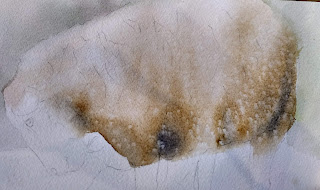PAINT CONSISTENCY
One of the main things a water color artist needs to tackle is how much water to add to the paint.
In the picture below, you can see 4 different paint to water ratios. The first (some people call this mustard consistency) is about 90/10 paint to water. The paint doesn't move around on the palette and is very dark.
Second is about a 50/50 ratio. There is enough water to make the paint easy to move around, still dark, but more transparent. Some refer to this as "cream" consistency. The third is about 25/75 paint to water. YOu can call it "coffee" or soy with wasabi. Color is lighter, the puddle of color moves around easily. The last, about 10/90 paint to water. Some refer to this as "tea", another artist calls it "soy sauce." This last is often used as a light first layer or wash.
Here are some bad habits to avoid.
1. Mix up enough paint ahead of time to cover all you want to cover. That way you can avoid having to make more at an inconvenient time. And you won't have to worry about not mixing the exact same color.
2. Don't keep dipping your brush in the water to rinse it if you are using the same color. Each time you rinse your brush, you are adding more water to your mixture, making it hard to make darker layers. Instead, mix enough of the consistency you want, and when you run out of paint, just dip your brush into the puddle of paint. When you want to change color, rinse your brush, dab the water out of it, then dip it into the new paint.
LOST/HARD/SOFT EDGES
You'll want to practice this a little before starting the sheep painting.
A HARD edge is a very precise edge formed on dry paper. It is painted with a wet brush on or against a dry area of the paper.
A SOFT edge looks fuzzy, indistinct, like a cloud, fur, cotton. It is formed by wetting the paper first, then painting into the wet area. Wet means it is shiny, not sopping, no puddles of water. You can experiment with different consistencies of paint into the wet area. Below on the left you see lines made by a thin brush onto wet paper. You have some control. On the right is a "puddle" of water, and shows that
the paint is far less controllable.
Below is a practice to learn how to do the sheep with LOST and SOFT edges. Lost edges occur when you create a place where the edge seems to vanish into the background. It is just no painted. YOu can
see the edge here that is mostly soft, then disappears, then continues on the right.
To practice making a soft edge and lost edge for the sheep, wet the area above and below the line for the sheep back. I turned it upside down to work, then applied the paint along the edge of the back and LET IT FLOW DOWNWARD, away from the edge of the sheep. If it begins to run too much into the wool, just take a thirsty brush and pull up the paint while wet.
You can work in small sections, as long as it is wet. Practice skipping a part to create a lost edge.
These pictures came from my friend and farmer neighbor. Her lambing season just finished, and these babies were newborns.
When you feel you are ready, make a soft edge on the painting. Wet not only the edge, but into the wool also. Turn the painting upside down, apply the paint along the edge of the back, and allow the
paint to flow AWAY from the sheep. Do this on edges you want to keep soft.
When you have done the entire background, dry the painting. Then wet the sheep where it will look woolly. Mix raw sienna and burnt umber for the wool color. Starting at the bottom of the sheep, where it will be darkest, apply the paint and let it run into the upper part of the sheep, trying to keep the top of the back white. You can add some blue to some dark areas at the belly and legs while wet.
Gently add a pinch of salt grains onto the sheep wool.
This is where we ended this week. Next week we'll work on the wool coat as in the picture below.
Here are some good very recent youtubes on these topics. Worth watching.
Louise DeMasi on water consistency and fixing mistakes
https://www.youtube.com/watch?v=RsZh4wKTKGQ
Louise DeMasi sheep partial tutorial/lost and hard edges






No comments:
Post a Comment